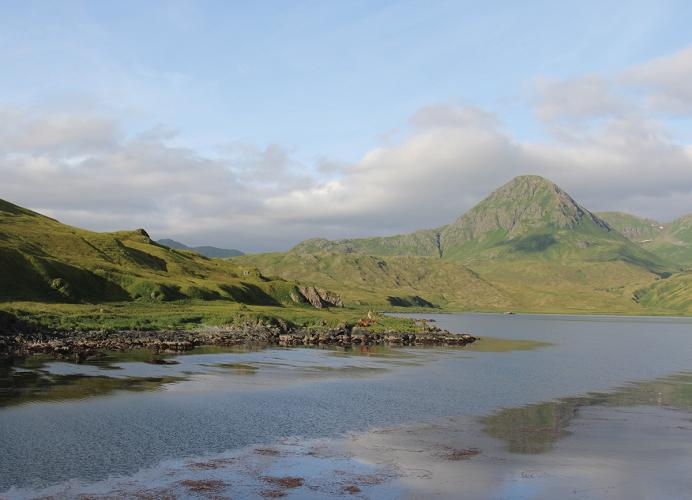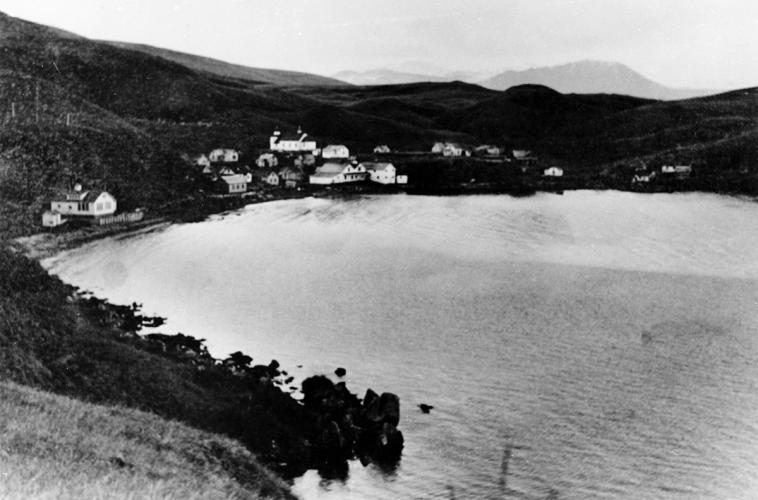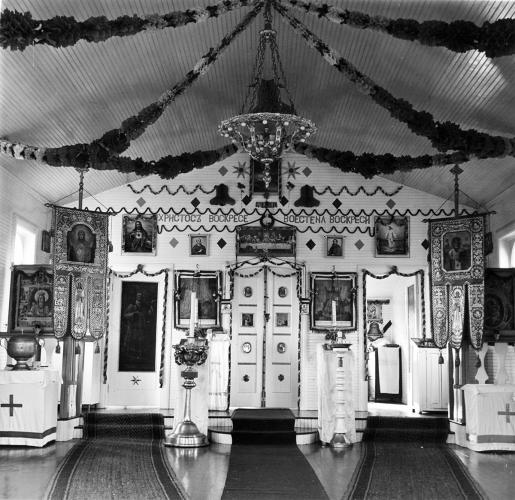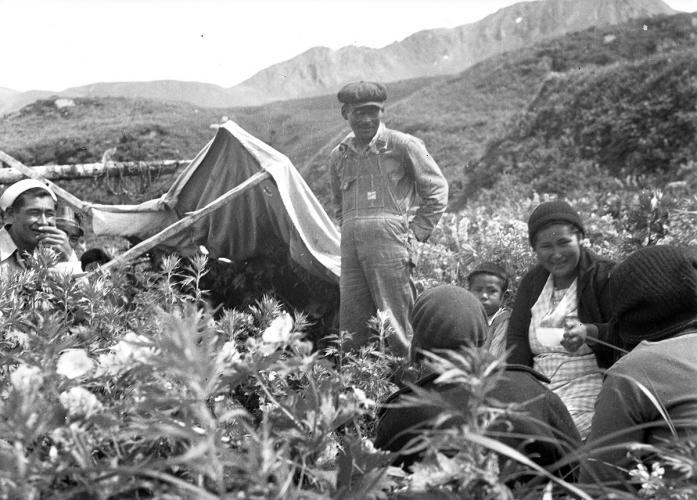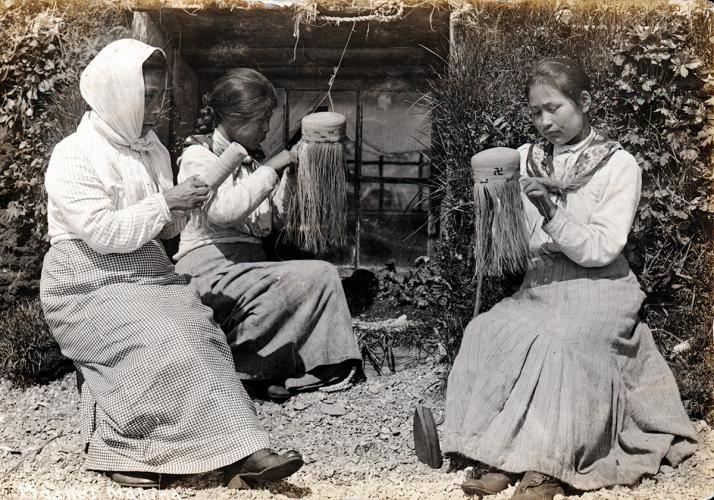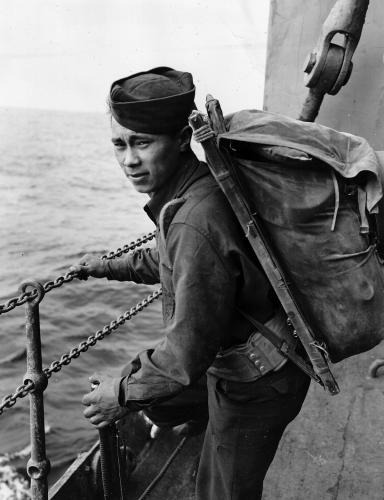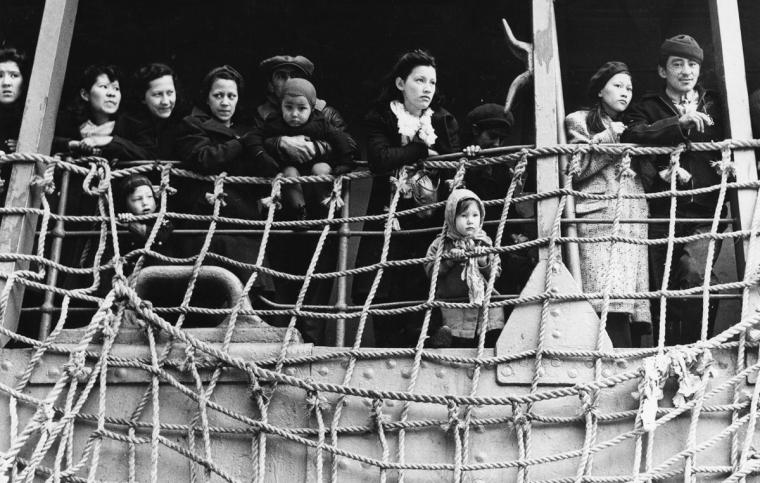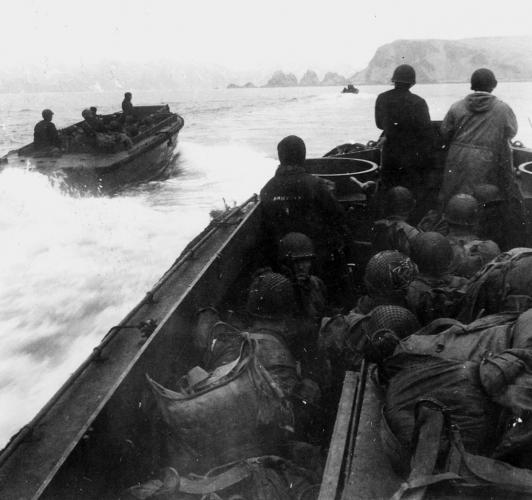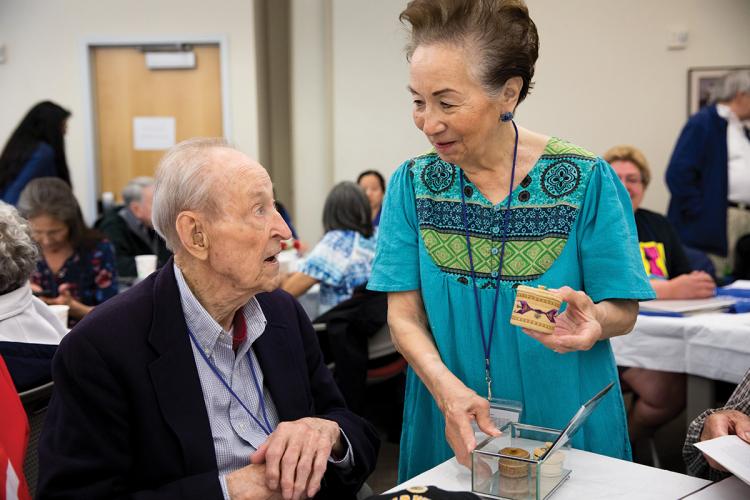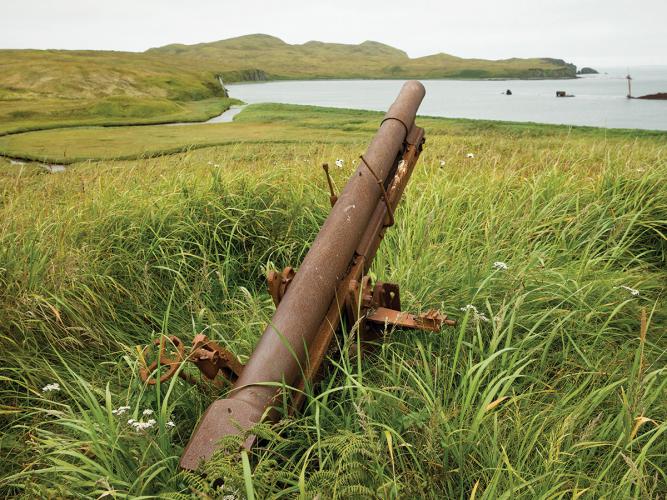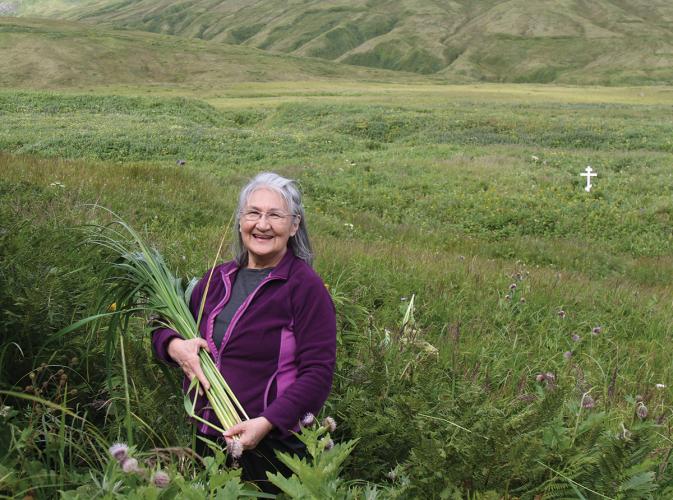As Alaska’s westernmost Aleutian Island came into view, Theresa Deal recalled, “I was getting chills.” Aboard a U.S. Fish and Wildlife Service (USFWS) research vessel, Deal was among the 11 passengers who in 2017 were the first Aleut people to step foot on Attu—or Atux̂as as they call the island—since World War II. “My mom was born here. She was forced to leave,” she said. “It was just magical. There’s not many adjectives that I could find that can describe the feeling of going back.”
The Aleut people, or Unangax̂ in their Native language, inhabited several villages in the Aleutian and Pribilof Islands off what was then Alaska Territory (this area would not become a U.S. state until 1959). As World War II approached, the Unangax̂ numbered just over 1,000 people living in 10 villages, which were inhabited by anywhere from 10 to 294 people.
The Aleutian Islands were strategically valuable for the United States, Canada and Japan. The Japanese invaded them to prevent the United States from building military air bases on the islands, which would have enabled U.S. planes to reach and bomb Japan. Japan also wanted to disrupt supply routes to the Soviet Union, build bases capable of reaching the Soviet Union if war with that country developed and draw U.S. forces away from the central Pacific.
On June 3, 1942—just six months after Japan’s attack on Hawaii’s Pearl Harbor—the Japanese bombed the U.S. military at Dutch Harbor on Unalaska Island, beginning what would become the 13-month, 1,000-mile-long Aleutian Islands Campaign. Unangax̂ from Attu to the Alaskan Peninsula were affected. Japanese ground troops occupied the western islands of Attu and Kiska with no resistance. When the Japanese invaded Attu Island early on June 8, they found 42 Unangax̂ as well as Fred and Etta Jones, a radio technician and a school teacher, living there. Fred Jones was killed and one Unangax̂ man later died; the others remained on the island with Japanese troops for three months. Then Japanese forces were ordered to go to nearby Kiska Island to support their troops and to remove all of Attu’s inhabitants. Now prisoners, they boarded a coal freighter with few personal effects and were transported to Kiska and then to Hokkaido, Japan. An Unangax̂ woman died along the way. The remaining Attuans became the only Alaska Native prisoners taken to Japan during the war.
In Japan, the Attuans were housed in vacant railway employee dormitories. Although allowed much freedom of movement, they experienced poor living conditions and some violence, and a policeman stole some of their rations. Henry Stewart reports in his 2008 book “Alaska at War 1941–1945: The Forgotten War Remembered” that nearly half of the Attuans in Japan perished, including 16 of the 40 detainees and four of five children born there. Most died from acute tuberculosis, which 20 Attuans developed soon after arriving. Starvation accelerated their condition. Ten to 15 Attuans were often hospitalized at a time. Because the 881 Unangax̂ who were still living in 10 communities on Alaska’s islands were in a combat zone, the U.S. government evacuated them hastily to six locations officially deemed “refugee camps” in southeast Alaska. U.S. military forces then burned their villages to deny the Japanese any benefit from them. The former villagers were now housed at unsanitary and abandoned canneries, a herring saltery and rotting gold mine camps that had no plumbing, electricity or toilets. With little potable water, low-quality food and limited winter clothing, the Unangax̂ were appalled by the conditions of the camps and suffered greatly.
Accustomed to the barren, treeless Aleutians, many struggled with the forested realms of their camps, experiencing claustrophobia and depression. Larry Chercasen, who grew up on Umnak Island and was relocated to Ward Lake near Ketchikan, said in a 2008 interview for the University of Alaska’s Oral History Project that “I woke up one morning, I looked out of the port hole and the ship was real still and I saw trees. … I wondered what they were, and I thought what are those, big grass?” he said. “It was the first time I’d seen a live tree in my life…And the first time I heard thunder and lightning in my life. It frightened me to death.”
The internment of the Unangax̂ lasted more than three years. Nearly 10 percent of the evacuees died in these camps.
Attuans in Military Service
Despite their situation, many Unangax̂ who had been in the camps still supported the U.S. war effort. Some escaped to find work with construction companies and military contractors. Others opened their homes for wounded or periodically shared their church on Unalaska Island with troops.
Aleut peoples from across the Aleutian Island chain and southeast Alaskan relocation camps also served in the military with distinction during World War II. Widespread induction of Aleut men did not occur until after the general relocation of Aleut peoples to southeast Alaska. There, men registered with local draft boards. Some did not wait for the draft and enlisted. Despite being interned, for example, evacuee Luke Shelikoff left the Lake Ward Refugee Camp to join the U.S. Army.
In May 1943, U.S. and Canadian forces stormed Attu to expel the Japanese. Among them were the 7th Scout Company and the 7th Reconnaissance Troop, which were combined to form the 350-man 7th Provisional Scout Battalion. This unit included a 30-man detachment from the 1st Alaskan Combat Intelligence Platoon (Provisional) of the Alaska Defense Command. Beginning in November 1941, the unit was commanded by Colonel Lawrence Castner, intelligence chief of the U.S. Army’s Alaska Defense Command. Members were recruited from Alaskan big game hunters, trappers, dogsledders, commercial fishermen, miners, prospectors and American Indian, and Inuit and Aleut peoples. Having no official uniform, they chose their own weapons and gear. Because the unit was composed largely of Alaskans, it quickly became known as the Alaska Scouts. Due to their dislike of dress code and unshaven nature, the group was dubbed Castner’s Cutthroats, although the name had no relation to their service.
The 66-man company was split into smaller commando-style teams. Having lived more than 8,000 years in the Aleutians, the Unangax̂ had extensive knowledge of their homeland’s food sources and geography, including the location of trails, the timing of tides and which harbors were safe in difficult winds. The military drew upon these Indigenous peoples’ invaluable information and survival techniques. According to a 1991 article in Alaska Magazine, Alaska Native Scout Drafin “Buck” Delkettie said, “We taught the Army instructors how to do things our way. How to take bear out of the woods, how to make our own snowshoes, how to go into the woods and catch your own food, how to just plain survive.”
Utilizing the Indigenous scouts’ ability to live off the land, Castner taught them how to gather military intelligence. Members conducted long-range reconnaissance to spot Japanese troops as well as ground surveys and mapping, including searching for potential runways and beachheads for amphibious landings without being detected. Selected as a scout because of his knowledge of the Aleutian Islands, Simeon Pletnikoff, known as “Aleut Pete,” relayed in a 1992 University of Alaska oral history recording that he and other Alaska Natives helped scout Adak and Amchitka Islands and later participated in the reclaiming of Attu Island. Often working in small parties, the Alaska Scouts were mobile: they were lightly armed, generally used nonmilitary equipment and lived off the land while searching for Japanese troops.
After securing Amchitka and Adak, U.S. forces prepared for the first amphibious island landing in U.S. history on Attu. A U.S. bombing campaign had destroyed Attu village prior to retaking the island. U.S. troops assaulted four beaches along the 40-mile-long Attu, with Alaska Scouts serving as guides, map readers, scouts, advisers and snipers. The Battle of Attu was the principal Allied effort to end Japan’s only military campaign in the Western Hemisphere and contained some of the bloodiest hand-to-hand fighting of World War II.
The Aleuts’ valuable service helped to expel the Japanese invaders. Yet, as several minorities in the Pacific Theater of World War II experienced, some Unangax̂ found themselves mistaken for the enemy. In his oral history interview Pletnikoff recalled, “I had a heck of a time. Out on the front line, the Americans would get ahold of me and want to kill me and all that. They tried to take me to the Provost Marshall for impersonating a U.S. soldier.” He would have to say to them, “What’s the matter with you guys? I’m an Aleut.”
On August 15, 1943, scouts landed to reconnoiter Kiska Island. Finding no Japanese, U.S. forces landed, officially ending the Aleutian Campaign. They did not know that the Japanese had evacuated the 5,183-man garrison nearly three weeks before, and while patrolling the island over the next eight days, dense fog and confusion resulted in Allied forces firing on one another.
Unangax̂ from the Pribilof Islands—representing nearly half of the population—experienced a different trajectory than others in the Aleutian Chain. Long dominated by the USFWS, these men were classified as “wards of the government,” which initially prevented them from enlisting in military service. Kept on their islands, they were used for their labor and hunting skills in the seal-hide trade. In 1943, several left for military service. As the draft drained local manpower at Funter Bay Camp, the USFWS was able to have Unangax̂ in the military furloughed and others deferred so they could participate in harvesting fur seals that summer. After 87 Pribilof inhabitants and 13 other Unangax̂ produced $1.58 million in furs and seal byproducts, those on active duty returned to their stations.
Resilience, Restitution and Reconnection
While the war for the Aleutian Islands ended in 1943, it was far from over for the Unangax̂. Some remained in relocation camps as late as 1945—two full years after Japanese troops left the Aleutians. Some returned to find their villages burned and destroyed. The surviving 25 Attuans—including Alfred Prokopeuff, the sole surviving Unangax̂ baby born in Japan—and those from smaller villages on other Islands were not allowed to return. These became known as the “Lost Villages.”
Taken from their homes, subjected to deplorable living conditions and losing most of their personal property, they persevered. They sustained themselves through devout focus on their version of Russian Orthodoxy, community values and inner strength. They protested and petitioned their treatment, left relocation camps to find work and refused the orders of their Japanese captors when possible. This resiliency would help them rebuild their lives after the war. However, Attuan survivors were scattered to other Aleut and Alaskan communities and to orphanages in Alaska and Washington, fracturing their remining community, language and culture. Less than 300 Attuan descendants are known to exist today. Many of the Unangax̂ remained silent about their ordeal for years, suppressing the story from grief and concern that they would be considered unpatriotic for speaking up about their treatment. Theresa Deal stated that her mother, Mariana Hodikoff—Attuan “prisoner number 36”—never spoke about her experiences in Japan.
After years of debate, U.S. government officials apologized to the Unangax̂ in 1988 and ordered restitution to 450 individuals for personal losses associated with their forced relocation and internment in southeast Alaska during the war. Under the terms of the American Civil Liberties Act of 1988, each survivor received $12,000. A $6.4 million trust fund was created for their communities.
While historians have often focused on the Battle of Attu, for the Unangax̂ the legacy of World War II has been one of both geographic and cultural loss. The impacts of lost islands and villages, harsh treatment, scattered resettlement and displacement continues. Yet even though there has been loss, there has also been recovery.
In a National Park Service article, Alice Snigaroff Petrivelli reflects on the relocation experience and how they have since rebuilt. “It was humiliating for independent Aleuts to be treated like children. The evacuation made Aleut people feel as though they had no rights whatsoever,” she said. “I noticed that we were referred to as ‘these people’ whenever there was a discussion about the evacuees. Well, ‘these people’ are now in control of their own destinies, as much as any American citizen is, and will continue to do a good job preserving their culture and traditions.”
Today Unangax̂ contribute as prominent community leaders throughout the United States. These include State Representative and businessman Carl E. Moses, physician Barbara Riley, sculptor John Hoover and Indigenous studies scholar Eve Tuck.
Restoring a Legacy
With the closing of the Casco Cove Coast Guard Station in 2010, a pre-GPS communications station, Attu is no longer inhabited. Most of Attu Island is within the Alaska Maritime National Wildlife Refuge, which encompasses 1,400 islands and is under the USFWS management. Although challenging to get to, Attu is open to the public. As Refuge Manager Steve Delehanty explained, however, “The actual site of Attu village is not owned by the federal government. It’s not part of the Alaska Maritime Wildlife Refuge. It belongs to the Aleut Corporation.” This is one of the Alaska Native–owned 13 regional bodies that own and manage land for their peoples. In addition to the metal, wood and stone remains scattered across the island during the war, some areas still contained leaked oil, petroleum and lead. The U.S. Army Corps of Engineers removed two petroleum leaks, numerous fuel tanks and other pollutants in 2016 under the Formerly Used Defense Site Program. Yet the island still does not have any facilities to accommodate lengthy public visits.
In 2012 an Attuan reunion in Anchorage, Alaska, allowed long-scattered relatives to reconnect, which led to the 11 descendants visiting the island in 2017. They were only able to reach the island with the help of a USFWS research vessel that had traveled two days to get there. During a five-hour visit, they held a remembrance service for all the Attuans near the remains of the former Attu village church. There they buried a Russian Orthodox cross, gathered soil, rocks and grass for basket weaving, walked on the beach and “maritime tundra,” and reconnected with their ancestors. Theresa Deal hiked to a memorial to the Attuans who once lived on the island. “That was an emotional thing. At least I’m glad that my mom’s name was on the survivor list because I’m here.”
In 2018 descendants of Attuans, American and Japanese soldiers met at the Alaska Aviation Museum in Anchorage to commemorate the 75th Anniversary of the Battle of Attu. There, they premiered the Japanese documentary film about the Battle of Attu called “When the Fog Clears.” Helena Pagano Schmitz and Theresa Deal, both descendants of Attu Tribal Chief Mike Hodikoff, met at this event and decided to found the all-volunteer, nonprofit organization called Atux̂ Forever. Through this initiative, they hope to make Attu more accessible to descendants to visit and reclaim their culture and homeland.
“I feel our story is left out of World War II,” Schmitz reflected. “We lost our culture, we lost our language, and we lost our way of life, and I’m trying to bring it back.” Theresa Deal said, “I think it’s important to have access to the island for all descendants and future descendants.”

